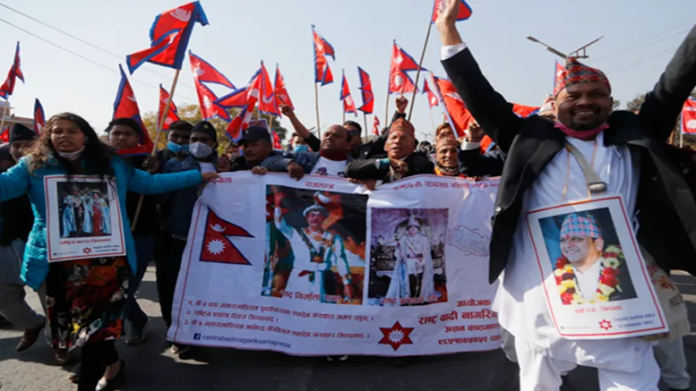As Nepal’s pro-monarchy movement grows stronger, questions are rising about India’s possible involvement. Some political leaders in Nepal have hinted that India might be quietly supporting the push to bring back former King Gyanendra Shah to the Narayanhiti Palace. The Himalayan nation, sharing over 1,850 kilometers of border with Indian states like Uttarakhand, Uttar Pradesh, Bihar, West Bengal, and Sikkim, has caught the attention of many in India, especially in the northeast.
Arrest of Royalist Leader Raises Questions
On April 11, a royalist movement leader was reportedly detained in Assam, India, and sent back to Nepal. Durga Prasai, accused of leading a violent protest in Kathmandu on March 28, was arrested by Nepali police in Jhapa district, near the Indian border. The protest left three people dead, including journalist Suresh Rajak.
It is believed that police in Assam picked up Prasai in Guwahati and handed him over to Nepali authorities. This incident highlights the sensitive nature of Nepal-India relations, especially with no active extradition treaty between the two countries.
Journalist’s Death Sparks Outcry
The tragic death of journalist Suresh Rajak during the protest drew attention from international organizations. The Press Emblem Campaign (PEC), a Geneva-based group that fights for media safety, expressed shock and grief over his killing.
PEC President Blaise Lempen called for a fair investigation and urged the government to provide proper compensation to Rajak’s family. He also noted that Rajak was the first journalist killed in Nepal this year and the 44th globally since January 1, 2025.
Public Anger and Rising Monarchist Sentiment
Nepal has been struggling with political instability, rising corruption, and growing public dissatisfaction. Many citizens feel that both ruling and opposition parties are more focused on their personal interests than the welfare of the people.
This frustration has fueled the rise of the pro-royalist Rastriya Prajatantra Party, which openly rejects the current political system and supports restoring Gyanendra Shah to the throne.
Government Crackdown on Protesters
In response, the Nepali government, led by Prime Minister KP Sharma Oli, has arrested hundreds of royalist protesters. Authorities have accused the former king of supporting violent unrest.
The government recently reduced the number of security personnel assigned to Gyanendra from 25 to 15. There are also reports that his passport may be revoked, and the Kathmandu Metropolitan Office has fined him NPR 793,000.
Prime Minister Oli even alleged that Uttar Pradesh Chief Minister Yogi Adityanath was secretly backing Gyanendra. Adityanath, a prominent Hindu nationalist, has openly supported restoring Nepal’s Hindu identity. He has hosted several visits of the former king to Lucknow in the past.
India’s Role and Influence
Yogi Adityanath, known for his saffron attire, shaved head, and religious tilak, once addressed a public gathering in Kathmandu ten years ago, promoting Nepal’s old Hindu identity. During recent protests, some royalist supporters carried life-size photos of both Gyanendra and Adityanath.
However, India’s official position remains firm. At the 6th BIMSTEC Summit in Bangkok on April 4, Indian Prime Minister Narendra Modi stated that India values a democratic Nepal. He reassured Nepal’s Prime Minister that as the world’s largest democracy, India stands by Nepal’s republican system.
Still, some Indian citizens expressed disappointment when Nepal changed its identity from the world’s last Hindu kingdom to a federal republic in 2008.
Is a Return to Monarchy Possible?
While a portion of Nepal’s population believes the monarchy is outdated, others suggest that the king should return in a symbolic role as head of state. Despite the calls, experts argue that restoring the monarchy is not practical.
A recent article in The Kathmandu Post explained why the monarchy is unlikely to return. It stated that Nepal’s future lies in facing current problems, not reviving its past. The article noted that Gyanendra lacks the political base needed for a comeback and described the crown as a relic of history.
Nepal continues to navigate its complex political landscape, balancing tradition with modern governance. While some look to the past for solutions, most citizens seem focused on improving the republic for future generations.


